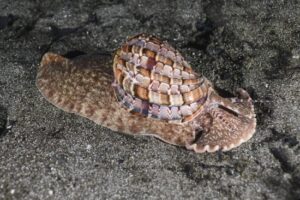True batfish belong to the order Platax, coming from the Greek word ‘Platys’, meaning ‘flat’, due to their distinct body shape. There are a few species that are not closely related to members of the Platax order, but are often called ‘batfish’ due to their similar body shape.
Adults resemble spades and have round, silver/yellow/dusky bodies with tall fins, whereas juveniles have longer fins, looking more like a boomerang, or a bat, which is how they got their common name.
All batfish species look alike in their adult form, but not as juveniles when they are very creative and even rebellious. Before they become conventional adults, they choose extravagant outfits as they try to find themselves in the vast greatness of the ocean. Some of them even try to mimic completely different animals, such as sea stars or poisonous sea slugs. Luckily for their adult parents, this is, truly, just a (juvenile) phase as they grow to be less extravagant in shape and colour as they reach maturity.
There are 5 different species of Platax:
Platax orbicularis (round batfish)
Adult round batfish live on coral reefs throughout the Indo-Pacific and often form large schools of up to one hundred members. The movement of their silver bodies gives the impression of a much larger organism, scaring off predators, proving that in the sea, there is strength in numbers.
On the other hand, juvenile round batfish are solitary or live in small groups and use their black bodies and long fins to camouflage themselves as dead leaves floating in the current, or turn rusty brown when they hide out in the mangroves.
Adults are often found accompanying green turtles on their swims around a reef. The reason for this, other than green turtles being very good company, is that they have very similar diets. They both feed on algae, invertebrates, and small fish. The round batfish often likes to delegate the task of ‘pre-digesting’ their food to the turtle, and they catch the meal immediately after it has left the turtle’s digestive system – some people might say that is batfish crazy!
Platax pinnatus (dusky batfish)
Dusky batfish are the most introverted of the batfish group. They avoid the company both of their kind and human divers. Even though they are not big on socializing, they are the heroes of reef ecosystems.
With black, bat-shaped bodies and yellow outlines, they resemble the famous bat signal that appears in the sky when Gotham City is in trouble. When coral reefs are in trouble, dusky batfish use their powerful snouts to eradicate harmful alga overgrowth, giving the reef a chance to recover.
Platax teira (tall-fin batfish)
The largest species in the group can grow up to 70cm (28in). Unlike their dusky cousins, tall-fin batfish are very curious and friendly and often approach divers (as you can see in the photos).
Juvenile batfish have fins that are much longer than their bodies and darker than in adults. These long, floppy fins are used as camouflage, helping them to hide among seaweed or marine debris.
Platax boersii (golden spadefish)
The golden spadefish inhabits the waters of Indonesia, New Guinea and the Philippines.
Juveniles are dull in colour, as this helps them blend in with the corals in the rocky reefs, but they gradually change their colour to bright yellow as they reach their golden years.
Platax batavianus (humpback batfish)
The majority of this population lives off the coast of Madagascar.
The juvenile humpback batfish do not try to blend in with their surroundings but has a zebra pattern on their bodies which makes them look like the venomous devil firefish, deterring even the bravest predators.
Written by Lena Ilic, Bachelor of Science, Marine Biologist
Photos by Ivana OK and Janez Kranjc
The post Get to know the Batfish appeared first on Mares – Scuba Diving Blog.
Read MoreDiving, batfish, biodiversity, coral reef, Indian Ocean, living sea, maldives, marine life, red seaMares – Scuba Diving Blog


